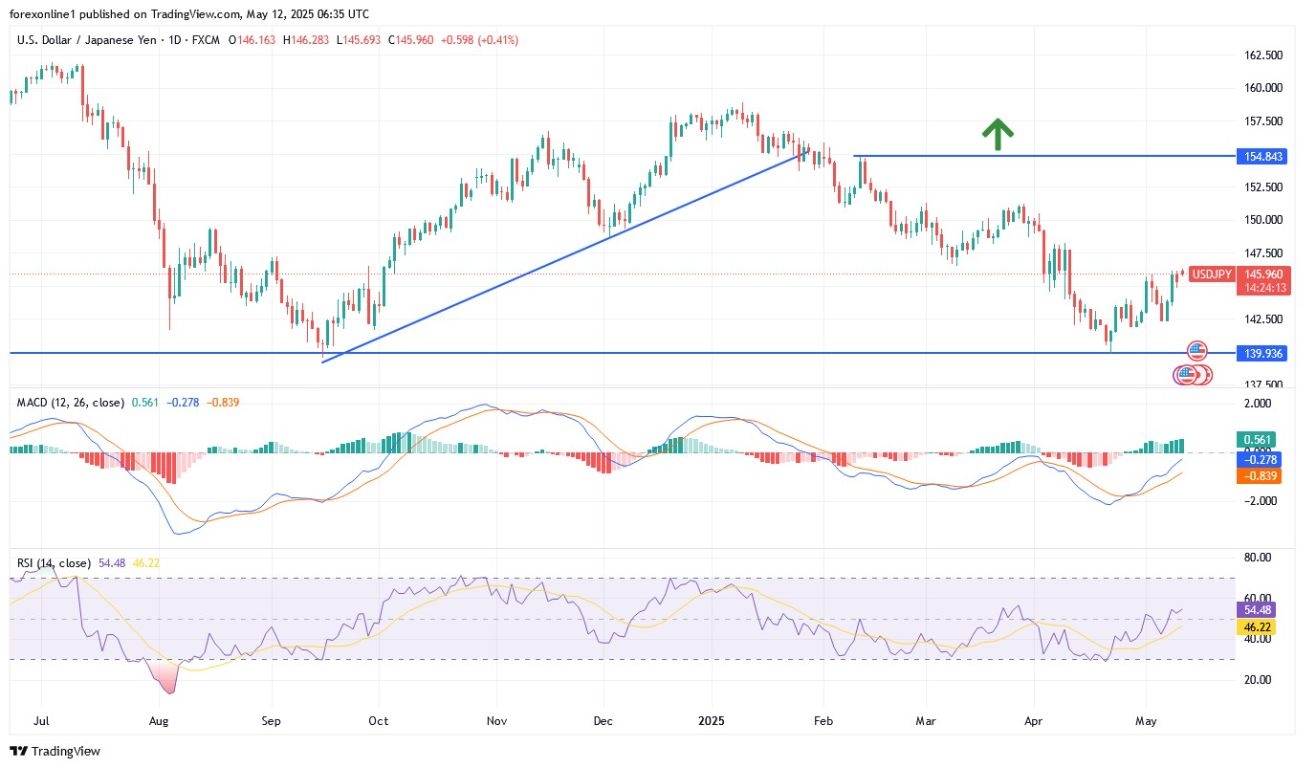- At the start of the US inflation week, the upward rebound gains for the USD/JPY currency pair continue, reaching the 146.28 resistance level, the highest for the pair in a month.
- Investors abandoned buying the Japanese Yen as a safe haven, as optimism about US-China trade negotiations led to a decline in demand for safe-haven assets.
- The USD/JPY pair's gains will face another important event during this week's trading, with the release of the US inflation reading, which strongly influences market expectations for the future policies of the US Federal Reserve.

Over the past weekend, officials from both countries indicated progress, with US representatives praising an agreement aimed at reducing the trade deficit, while Chinese leaders described the outcome as an "important consensus." Meanwhile, US Trade Secretary Howard Lutnick stated that the basic 10% tariff on other countries will "likely remain in place for the foreseeable future." Investors also closely monitored the ongoing trade talks between the US and Japan, with Tokyo seeking to reach an agreement by June. Domestically, Japan recorded a current account surplus of 3.45 trillion yen in March, following a record surplus of 4.06 trillion yen in February.
Trading Tips:
Obviously, the upward shift in the USD/JPY pair requires an end to the trade dispute between the United States and global economies. Furthermore, failure to do so could lead to renewed selling of the currency pair.
Positive Investor Sentiment Lifts Japanese Stock Prices:
During today's trading and across stock trading company platforms, the Japanese Nikkei 225 stock index rose by 0.2% to reach 37,600 points, while the broader Topix index rose by 0.4% to reach 2,744 points, marking its highest level in six weeks. This increase came as the US indicated "tangible progress" in trade negotiations with China over the weekend in Switzerland. The US highlighted its efforts to reduce its trade deficit, while Chinese leaders affirmed reaching an "important consensus."
However, US Trade Secretary Howard Lutnick indicated that the basic 10% tariffs on other countries are expected to remain in place "for the foreseeable future." Investors also monitored the ongoing trade negotiations between the US and Japan, with Tokyo aiming to finalize a potential agreement by June. According to trading, gains were led by the shares of major companies included in the index, including Kawasaki Heavy Industries (up 3.9%), Disco Corp (2.5%), Fujikura (1.8%), Advantest (4%), and IHI Corp (1%).
Japan's Services Sentiment at Lowest in Over 3 Years:
According to an official announcement today, Japan's services sector index fell to 42.6 points in April 2025, from 45.1 points in the previous month, marking its lowest level since February 2022 and the fourth consecutive month of decline. The household budget trends index in housing-related sectors decreased, but it increased in the food and beverage sector. The corporate trends index also declined, affected by the non-manufacturing sector's decrease. Employment also saw a decline during this period. Meanwhile, the economic outlook index fell to 42.7 points in April, its lowest level in four years, from 45.2 points in March, reflecting increasing concerns about the impact of US trade policy and persistent cost pressures.
USD/JPY Technical analysis and Expectations Today:
According to recent trading, the USD/JPY pair continues to trade above the 100-hour moving average by a few levels. Last Friday's decline helped the currency pair recover from the overbought condition of the 14-hour Relative Strength Index. In the short term, bears will target selling moves towards the support level of 145.60, then to the support of 145.00, respectively. Conversely, bulls will look to capitalize on upward rebounds with gains to the resistance level of 146.30, then to the resistance of 146.85, respectively.
In the long term, according to the performance on the daily chart, the USD/JPY pair is trading within a descending channel. However, the 14-day Relative Strength Index recently rebounded to avoid moving into oversold levels. Therefore, bulls will target extended rebounds at the resistance level of 147.50, then to the psychological resistance of 150.00, respectively. Conversely, over the same time frame, bears will seek to capitalize on the current wave of declines to move towards the support level of 143.00, then to the psychological support of 140.00, respectively.
Want to trade our USD/JPY forex analysis and predictions? Here's a list of forex brokers in Japan to check out.
